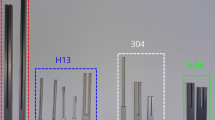Abstract
A new device is built to measure the mechanical characters of the double ended tuning fork which is used as the sensitive element of resonant sensor. It is mainly composed of a three dimensional workbench, a force sensor, a servo motor, control circuit and a photodiode. Detailed theoretical analysis is carried out to verify the feasibility of the design and some experiments have been done to test the performance of the device. Firstly, the calibrated result of the force sensor shows that the applied force possesses good linear relationship with the output voltage. Then, zero drift character indicates that the force drift is just 0.1N and the stability performance of the applied force is also detected. Finally, the axial force loading test is carried out. In conclusion, the above experiments prove that the designed scheme is right and reliable to measure the mechanical characters of the double ended tuning fork.
Similar content being viewed by others
References
M. Elwenspoek and R. Wiegerink, Mechanical microsensors, Berlin, Springer (2001) 245–257.
Masayoshi Esashi, Resonant sensors by silicon micromachining, Proceedings of the Annual IEEE International Frequency Control Symposium (1996) 609–614.
K. Azgin and L. Valdevit, The effects of tine coupling and geometrical imperfections on the response of DETF resonators, Journal of Micromechanics and Microengineering, 23 (12) (2013).
K. Fukuzawa et al., Monolithically fabricated double-ended tuning-fork-based force sensor, Journal of Applied Physics, 99 (9) (2006).
C. Li et al., A resonant sensor composed of quartz double ended tuning fork and silicon substrate for digital acceleration measurement, Review of Scientific Instruments, 85 (3) (2014).
A. Cheshmehdoost and B. E. Jones, Design and performance characteristics of an integrated high-capacity DETF-based force sensor, Sensors and Actuators a-Physical, 52 (1–3) (1996) 99–102.
C. Li et al., A resonant sensor composed of quartz double ended tuning fork and silicon substrate for digital acceleration measurement, Review of Scientific Instruments, 85 (3) (2014).
H. Osumi and T. Tomiyama, Development of force control device with high power and high resolution, IEEE/RSJ International Conference on Intelligent Robots and Systems (IROS 2008) (2008) 949–954.
F. Nagata et al., Automatic control of an orthogonal-type robot with a force sensor and a small force input device, IECON 2011 — 37th Annual Conference on IEEE Industrial Electronics Society (2011).
Author information
Authors and Affiliations
Corresponding author
Additional information
Recommended by Associate Editor Moon Ki Kim
Guo Zhanshe is an associate professor in Beihang University. He currently engaged in the studies of MEMS and advanced measurement technology.
Li Yilun is studying for master degree in Beihang University. His major is in measure and control technology and instrument. He currently engaged in measurement of gyroscope.
An Ying is studying for master degree in Beihang University. Her major is in measure and control technology and instrument. She currently engaged in measurement of MEMS sensor.
Rights and permissions
About this article
Cite this article
Zhanshe, G., Ying, A., Yilun, L. et al. A new device built to measure the mechanical characters of the double ended tuning Fork. J Mech Sci Technol 28, 5055–5062 (2014). https://doi.org/10.1007/s12206-014-1126-y
Received:
Revised:
Accepted:
Published:
Issue Date:
DOI: https://doi.org/10.1007/s12206-014-1126-y




